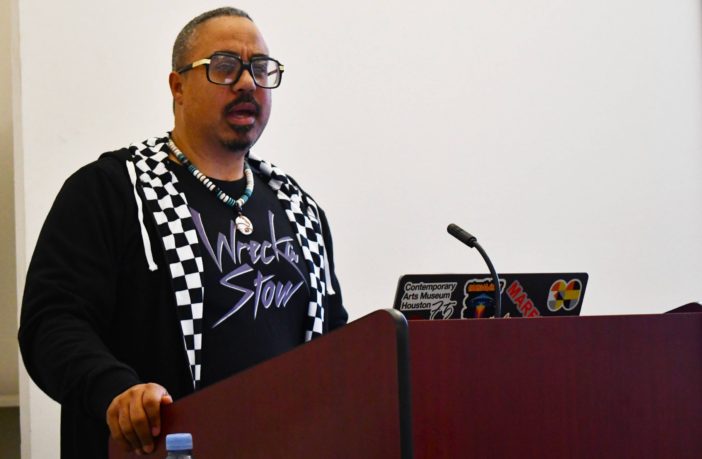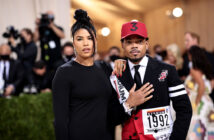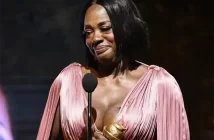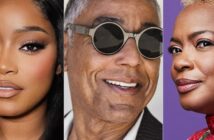Walking into Room 204 of the University of Houston’s Fine Arts Building, you immediately know you’re in for a unique experience. Even before class starts, the professor, noted artist, filmmaker, award-winning photographer, and graphic artist Marc Newsome (aka Marc Furi) is playing tune after tune from Prince’s vast catalog.
And Newsome is not spinning the “usual suspects,” Prince hits known by fans and non-fans alike. Rather, the classroom is filled with songs from Prince’s soundtrack album/CD, “Under the Cherry Moon;” songs only the truly advanced (i.e. die-hard) Prince fans would recognize and appreciate: “Christopher Tracy’s Parade,” “New Position,” “I Wonder U.”
Prince performing at Super Bowl XLI in Miami in February 2007. Photo by Chris O’Mera/AP.
The official name of Newsome’s class is “Prince,” but it could very well be called “Everything You Ever Wanted to Know About the Greatest Artist in History” because the professor drenches students with his unabashed love of the Minneapolis-born artist who at various times during his career was known as “His Royal Badness,” “Jamie Starr,” “Alexander Nevermind,” “The Symbol,” “The Artist Formerly Known as Prince,” and simply “The Artist.”
The Defender scored an exclusive interview with Newsome, who gave us a breakdown of his class.
Defender: Why is Prince a person worthy of study?
Newsome: Because of his track record where he did 49 albums and four films that people know about. He was trailblazing in fashion, in his approach to creating songs and music, and blending all kind of different genres, not only from Black music like funk and soul, but also rock, new wave, punk, electronic music. He was very experimental with sound art as well in his songs. So, when you hear a cool keyboard solo in the song “Head,” that’s experimental keyboard playing using synthesizers of that time. And even “Get It Up” by The Time, like the way the synthesizers sounded. And, he experimented with his presentation. He did dramatic interpretations when he was doing some of his songs, like when he was performing on stage. I thought that was pretty incredible. He was also really great at pulling at your emotions.
Defender: How did the class come about?
Newsome: I’m in the UH Master of Fine Arts program. They encourage people in the program to teach a class. As opposed to doing “Intro to Photoshop” or something like that, I wanted to do something more out-of-the-box. So, I proposed a Prince class because he is a historical figure with many different art practices. If you really dig deep, he did all sorts of things: performance art, fashion, music. I wanted to present that to students so they could understand what kind of guy he was. He was like a supernatural being, as far as I’m concerned, how he could do all the things that he did: never sleep and always produce work, made 49 albums while he was alive. And that’s not including the ones that are coming out after he died, in the Vault. So, I created a curriculum, presented it to the UH higher-ups, and they said, cool.
Defender: When were you introduced to Prince?
Newsome: My first introduction to Prince was actually when I went to private school. I was in maybe sixth grade. This freckle-faced kid named Rocky turned me on to Prince. It was the “Controversy” album. He had this cassette tape and we listened to it at recess, and I was like, “Okay, it’s cool.” That planted a seed in my mind. Then, when “Little Red Corvette” came out, I was like, “Who is this guy? This is amazing.” I just got sucked into Prince at that point. One of the first cassettes I ever owned was Prince’s “1999.”
Defender: Besides jamming Prince tunes, what do you have your students doing?
Newsome: I wanted to have the students engaged in a way where they’re creating projects based on things that Prince did. For example, his outfits represented something to him. It was like his persona… Prince came up with the idea of everybody [in his original band]to pick out a look, and he was going to have the persona pure sex… Everybody in my class has an art practice because it’s an art program, and I wanted everybody to come up with their own persona based on their art practice. So, I got them to come up with their own look, their own style. And each week we present where we’re at as far as developing these personas based on their art practice.
Defender: What’s the main thing you want students to walk away with understanding about Prince?
Newsome: I want [students]to realize the good, the bad, the stuff he did. He was a cosmic being living a physical, earthly, human experience… And then he left. I want to show people the possibilities of what they can do. I also wanted to give them certain philosophical nuggets as far as how to expand their own art practices. Prince had a lot of failures and he kept on going. For example, he opened up for the Rolling Stones and got chicken bones and bottles thrown at him. He gave up, but he came back and he did it again and he went harder with his performing. His first show, the very first show he did in Minneapolis, he failed. It wasn’t a good show. Then, he leveled up, and it became a great show. Every time he failed he came harder with it. I wanted to show students how to develop that mindset for their own art. He also had a lot of vulnerability in his songs; things that happened to him. He made songs about unrequited love and the vulnerability that goes with it. Listening to those lyrics, I started realizing that was his strength: the fact that he could be vulnerable, be in the defeatist position, but embrace that and make it powerful.
Defender: What aspect of Prince are today’s students just not getting?
Newsome: I think a lot of it is they just weren’t exposed to Prince, so they don’t know. They saw him as an adult, but they never saw him as a 20-year-old like they are. I’m going through the method of showing them Prince in his twenties and what he was capable of and what he was doing, the good, the bad, and the ugly. The fact that he had a lot of girlfriends. The fact that he was a control freak. And being a 24-year-old, being a boss of 35-year-olds. He got put in that position and he embraced it versus running from it. He turned down having Maurice White [founder of Earth, Wind & Fire]as a producer just so he could do all his own music… I expose students to musical genres, because they’re mostly 20-year-olds, so they don’t know the difference between funk and disco. They don’t know what funk is.



